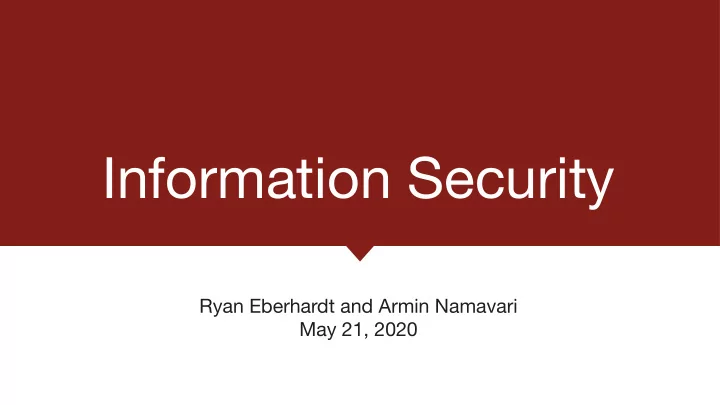

Information Security Ryan Eberhardt and Armin Namavari May 21, 2020
Today How do you keep information safe and sound? ● Could be an entire class by itself! ● ○ Today’s lecture isn’t even a high-level overview… it’s just a slice of the topic, from the perspective of networked systems design
Networked services Recall: In a networked service, a server listens for connections from one or ● more clients ○ When a connection is established, the client sends the server some request (usually using a protocol/“language” like HTTP) ○ The server interprets the request and sends some response back over the connection What threats might we need to defend against if our server has sensitive ● information?
Today Today: ● ○ Don’t give information to attackers that ask nicely ○ Make sure your dependencies don’t give information to attackers that ask nicely ○ Don’t give information to attackers that don’t ask nicely
Level 1: Don’t give information to attackers that ask nicely
Level 1: Don’t give information to attackers that ask nicely Stupid attack: ● GET /super/secret/sauce HTTP/1.1 Attacker Server HTTP/1.1 200 OK The secret sauce is MSG No one would be that silly, right? ●
Panera Bread mobile ordering app GET /foundation-api/users/uramp/7382194 HTTP/1.1 Attacker Server "phones": [ "isSmsGlobalOpt": false, "subscriptions": { HTTP/1.1 200 OK { "isEmailGlobalOpt": true, "subscriptions": [ "id": 18295989, "isMobilePushOpt": false, { { "phoneNumber": "redacted", "birthDate": { "subscriptionCode": 1, "customerId": 7382194, "phoneType": "Residential", "birthDay": "redacted", "displayName": "Reward Reminders & Expiration Alerts", "username": "redacted@cox.net", "countryCode": "1", "birthMonth": "redacted", "isSubscribed": false, "firstName": "redacted", "extension": null, "birthYear": "redacted" "tncVersion": null "lastName": "redacted", "name": null, }, }, "loyalty": { "isSmsOpt": false, "userPreferences": { { "cardNumber": "redacted" "isCallOpt": false, "foodPreferences": [ "subscriptionCode": 2, }, "isDefault": true, { "displayName": "Panera Bread Updates & Special Offers", "emails": [ "isValid": true, "code": 3, "isSubscribed": false, { "smsPreferences": [ "displayName": "Low Fat" "tncVersion": null "id": redacted, { } } "emailAddress": “redacted@cox.net", "programName": "Delivery", ], ], "emailType": "Personal", "isOpt": false, "gatherPreference": { "suppressors": [ "isDefault": true, "isOptPending": false "code": 7, { "isOpt": true, } "displayName": "Meal with family" "suppressionCode": 1, "isVerified": true ] } "displayName": "Catering", } } }, "isSuppressed": false ], ], },
Panera Bread mobile ordering app GET /foundation-api/users/uramp/7382194 HTTP/1.1 Attacker Server Sequential IDs: you could trivially enumerate every ID and download their entire database ● Case study in how not to handle a security breach: ● ○ Blew off security researcher for 8 months ○ Within two hours of researcher going to the press, announces issue is fixed and only 10k users affected ■ Look at the user ID above! 7382194 >> 10000 ○ Did not actually fix vulnerability! Same mistake was present on dozens of other API “endpoints” as well as other applications https://medium.com/@djhoulihan/no-panera-bread-doesnt-take-security-seriously-bf078027f815 ● Note: Not trying to pick on Panera. Bad attitudes towards security are endemic throughout industry (part of ● the motivation for teaching this class!)
How do we avoid this?
Authentication and authorization Authentication: who are you? ● ○ Established by supplying credentials (e.g. username/password, 2FA authentication token, secret key, etc.) Authorization: are you allowed to do what you’re trying to do? ● ○ Established by some security policy (e.g. a user may access his/her own emails, but not the emails of other people) A secure service must establish both ●
Common setup Authentication My username is cactus and my password is prickly Great! Use this token next time you talk to me: abc123 Show me emails for user cactus. My token is abc123 Client Server Validate abc123 Check that cactus has necessary permissions Here are emails for user cactus : … Authorization Authentication: clients must demonstrate their identities ● Authorization: server must check permission before carrying out request ● Tokens aren’t strictly necessary here, but provide a mechanism for expiring credentials ● after some time ○ Cookies = tokens
Life without authentication: SaltStack Last week, we alluded to clusters of hundreds or thousands of machines ● used to provide scale and availability You can’t manage that many machines by SSHing in individually ● Compute node Application 🔑 My CPU usage is 68%! SaltStack SS Minion master 🔑 My CPU usage is 20%! Compute node Application SS Minion
Life without authentication: SaltStack Last week, we alluded to clusters of hundreds or thousands of machines ● used to provide scale and availability You can’t manage that many machines by SSHing in individually ● Compute node Application SaltStack 🔑 Install version 10 SS Minion master Job queue: 🔑 Install version 10 Compute node 🔑 Please update the Application servers to version 10 SS Minion System administrator
Life without authentication: SaltStack SaltStack accidentally exposed a function to network requests that enqueues ● messages Was never intended to be called directly in network requests ● Compute node _send_pub(): install Application SaltStack 🔑 Install bitcoin miner bitcoin miner and kill SS Minion master SSH Attacker 😉 Job queue: 🔑 Install bitcoin miner Compute node 🔑 Please update the Application servers to version 10 SS Minion System administrator
Life without authentication: SaltStack Exactly three weeks ago, companies’ entire clusters started becoming ● unreachable ○ Many of them targeted with bitcoin mining + backdoor ○ DigiCert, Algolia, Ghost, Xen Orchestra, LineageOS, others ○ Nightmare to fix! Once you manage to get back in, how do you verify attackers aren’t still hiding? ○ https://duo.com/decipher/saltstack-flaw-used-in-numerous-attacks ○ https://blog.sonatype.com/saltstack-20-breaches-within-four-days
Life without authorization: LocationSmart LocationSmart is a location tracking service that partners with every major US ● cell carrier and sells location data (e.g. to law enforcement, marketing agencies, companies wanting to track corporate devices) ○ Location data is collected via cell phone tower triangulation. Impossible to opt-out
Life without authorization: LocationSmart The company offered a demo website that shows your own location on a map ●
Life without authorization: LocationSmart POST /try/api HTTP/1.1 requestdata={“deviceType":"Wireless","deviceID":" 8005551212 ","devicedetails":"true", "carrierReq":"true"}&requesttype=statusreq.json HTTP/1.1 200 OK {“uid":"REDACTED", “requestTime":"2018-05-16T21:25:50.689+00:00", “statusCode”:0, “statusMsg":"Success", “deviceId":"8005551212", “token":" TOKEN ", “locatable":"True", “network": {"carrier":"T-Mobile", “locatable":"True", “callType":"wireless", "locAccuracySupport":"Precise Possible”, “nationalNumber":"8005551212", “countryCode":"1", “regionCode":"US", "regionCountry":"UNITED STATES”}, “subscriptionGroup":[{"name":"LOCA-D01-LOCNOPIN", “locatable":"False", “smsAvailable":"False"}, {“name":"LOCA-D02-WELCOME", “locatable":"False", Client Server “smsAvailable":"False"}], “smsAvailable":"True", “privacyConsentRequired":"True" , “clientLocatable":"false", "clientSMSAvailable":"Not supported”, "whiteListed":"false"}
Recommend
More recommend